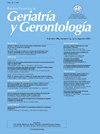[患有虚弱症和肌肉疏松症的墨西哥老年人的股直肌和股间肌厚度]。
Q3 Medicine
引用次数: 0
摘要
背景和目的:老年人体弱是一种老年综合征,在过去十年中日益受到重视。然而,目前仍没有关于诊断工具的综合信息,因此无法及时识别并提供适当的治疗方法。本研究旨在确定患有虚弱症和肌肉疏松症的墨西哥老年人的股直肌厚度(GMRF)和中间阔肌厚度(GMVI):横断面、描述性和比较性研究,研究对象为老年病科收治的年龄≥65 岁的患者。根据 FRAIL(虚弱与非虚弱)和 SARC-F(高风险与低风险)分类进行选择;通过超声波评估 GMRF 和 GMVI。数据通过社会科学统计软件包(SPSS)25 版进行分析。结果:研究组和对照组接受评估的患者人数分别为 136 人。在年龄(岁)方面,研究组与对照组的虚弱状态存在显著差异(虚弱:75.06±7.92 vs. 非虚弱:71.60±5.56;PC 结论:研究结果表明,虚弱状态与非虚弱状态存在显著差异:研究结果表明,在体弱和肌肉疏松症方面,墨西哥老年人的 GMRF 和 GMVI 存在显著差异。因此,本调查为在老年人群中使用超声波评估奠定了临床基础。本文章由计算机程序翻译,如有差异,请以英文原文为准。
Grosor del músculo recto femoral y músculo vasto intermedio en adultos mayores mexicanos con fragilidad y sarcopenia
Background and objective
Frailty in older adults is a geriatric syndrome that has gained importance in the last decade. However, there is still no consolidated information regarding diagnostic tools that allow timely identification, and therefore, provide an appropriate therapeutic approach. The objective is to determine the Thickness of the Rectus Femoris Muscle (GMRF) and Thickness of the Vastus Intermedius Muscle (GMVI) in older Mexican adults with frailty and sarcopenia.
Material and methods
Cross-sectional, descriptive and comparative study in patients ≥65 years of age, admitted to the geriatrics service. The selection was according to the FRAIL (frail vs. non-frail) and SARC-F (high risk vs. low risk) classification; evaluating GMRF and GMVI by ultrasound. The data were analyzed through the statistical software Statistical Package for Social Sciences (SPSS) ver. 25.
Results
The number of patients evaluated in the study and control group were 136 respectively. Significant differences were found regarding frailty status in age (years) (Frail: 75.06 ± 7.92 vs. Non-frail: 71.60 ± 5.56; P<.001), GMRF (mm) (Frail: 8.41 ± 3.08 vs. Non-frail: 11.03 ± 3.50; P<.001) and GMVI (mm) (Frail: 6.53 ± 2.64 vs. Non-frail: 8.66 ± 2.68; P<.001); Considering sarcopenia, there were differences in age (years) (High risk sarcopenia: 75.17 ± 7.84: vs low risk sarcopenia; 71.49 ± 5.60; P<.001), GMRF (mm) (high risk sarcopenia: 8.45 ± 3.11 vs low risk sarcopenia: 10.98 ± 3.50; P<.001) and GMVI (mm) (High risk Sarcopenia: 6.67 ± 2.63 vs Low risk Sarcopenia: 8.52 ± 2.79; P<.001).
Conclusions
The results found show that there is a significant difference in GMRF and GMVI in Mexican older adults with respect to frailty and sarcopenia. In this way, the present investigation establishes clinical bases for the use of ultrasonography assessments in the geriatric population.
求助全文
通过发布文献求助,成功后即可免费获取论文全文。
去求助
来源期刊

Revista Espanola de Geriatria y Gerontologia
Medicine-Medicine (miscellaneous)
CiteScore
1.90
自引率
0.00%
发文量
62
审稿时长
85 days
期刊介绍:
Una revista de gran prestigio por sus artículos originales de investigación y revisiones. Permite cubrir todas las áreas de la medicina pero siempre desde la atención al paciente anciano, y está presente en los más reconocidos índices internacionales.
 求助内容:
求助内容: 应助结果提醒方式:
应助结果提醒方式:


